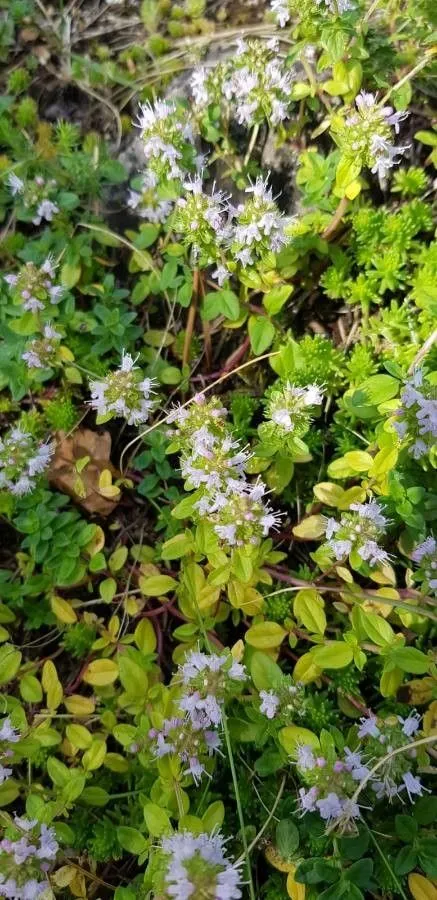
Author: L.
Bibliography: Sp. Pl.: 592 (1753)
Year: 1753
Status: accepted
Rank: species
Genus: Thymus
Vegetable: False
Observations: Europe
Large thyme, scientifically known as Thymus pulegioides, is a perennial herb that belongs to the Lamiaceae family. Described and classified by Carl Linnaeus in his seminal work “Species Plantarum” in 1753, this aromatic plant is native to Europe and has been a staple in various culinary and medicinal practices throughout history.
Large thyme typically grows in sunny, well-drained habitats. It can often be found flourishing in meadows, open woods, and gardens where it is cultivated for its attractive foliage and fragrant properties. The plant features small, oval leaves that emit a strong, pleasant aroma when crushed, a signature characteristic of many members of the mint family. It produces clusters of tiny, tubular flowers which range in color from pink to purple, adding visual appeal to its aromatic benefits.
Europeans have utilized Thymus pulegioides not just for its culinary versatility but also for its medicinal properties. Traditionally, it has been employed as a remedy for various ailments due to its antiseptic, antifungal, and antioxidant qualities. Herbalists have long valued large thyme for its potential to alleviate respiratory issues, digestive problems, and to fortify the immune system.
In the kitchen, large thyme serves as a versatile herb that enhances the flavor profile of numerous dishes. It is a common ingredient in Mediterranean cuisines and pairs well with meats, soups, stews, and vegetables. Its robust flavor can stand up to long cooking times, making it ideal for slow-cooked recipes and marinades.
Growing large thyme in a home garden is relatively straightforward. The plant thrives in areas with full sun and prefers well-drained soil. It’s drought-tolerant once established, making it a low-maintenance addition to herb gardens. Regular harvesting encourages new growth and ensures a continual supply of fresh leaves for culinary use.
Thymus pulegioides, or large thyme, is a multifaceted herb with significant ecological, medicinal, and culinary benefits. Whether you cultivate it for its aromatic leaves, use it to add depth to your dishes, or explore its traditional medicinal uses, large thyme remains a valuable plant in various aspects of life. Its resilience and ease of cultivation also make it a popular choice for gardeners across Europe and beyond.
Deu: arznei-thymian, arzneithymian, feld-thymian
Dan: bredbladet timian
Eng: large thyme, large-garden, lemon thyme, wild thyme, creeping thyme, large garden, large wild thyme
Nob: bakketimian
Nno: bakketimian
Nld: grote tijm
Fin: nurmiajuruoho
Swe: nurmiajuruoho, stortimjan, bredtimjan
Fra: serpolet commun, thym faux-pouliot, thym de bergère, thym laineux, thym serpolet
Cym: gruwlys gwyllt mwyaf, gruwlys mwyaf, teim gwyllt mawr
Gla: tím chapaill
En: Large thyme, Wild thyme, Lemon thyme, Large-garden, Large Garden, Large Wild Thyme, Creeping thyme, Broad-leaved Thyme
Be: Чабор блышыны
Bg: Планинска мащерка
Cs: Mateřídouška vejčitá
Da: Bredbladet Timian
Nl: Grote tijm
Et: Paljalehine liivatee
Fi: Nurmiajuruoho
Fr: Thym faux pouliot, Serpolet commun, Thym faux-pouliot, Thym de bergère, Thym laineux, Thym serpolet, Thym commun
De: Arzneithymian, Breitblättriger Thymian, Arznei-Thymian, Feld-Thymian, Gemeiner Thymian
Hu: Hegyi kakukkfű
It: Timo goniotrico
Lt: Keturbriaunis čiobrelis
Nb: Bakketimian
Nn: Bakketimian
Fa: آویشن لیمویی
Pl: Macierzanka zwyczajna
Gd: Tím chapaill
Sk: Dúška vajcovitá
Es: Serpillo, Sérpol
Sv: Stortimjan, Nurmiajuruoho, Bredtimjan
Cy: Teim gwyllt mawr, Gruwlys Gwyllt Mwyaf, Gruwlys Mwyaf
Taken Oct 16, 2017 by Yoan MARTIN (cc-by-sa)
Taken Aug 15, 2020 by Maarten Vanhove (cc-by-sa)
Taken Oct 16, 2017 by Yoan MARTIN (cc-by-sa)
Taken Aug 16, 2021 by Lutz Lissy (cc-by-sa)
Taken Sep 3, 2022 by Jani Zadrgal (cc-by-sa)
© copyright of the Board of Trustees of the Royal Botanic Gardens, Kew.
© copyright of the Board of Trustees of the Royal Botanic Gardens, Kew.
Taken Sep 3, 2022 by Jani Zadrgal (cc-by-sa)
Taken Oct 16, 2017 by Yoan MARTIN (cc-by-sa)
Taken Oct 28, 2019 by Pietro Brignoli (cc-by-sa)
Taken Aug 25, 2020 by maxime mullier (cc-by-sa)
Taken May 26, 2017 by Tela Botanica − Jean-Paul Hubert BOURSEAU (cc-by-sa)
Taken May 14, 2015 by Tela Botanica − Paul FABRE (cc-by-sa)
Taken Aug 10, 2013 by Tela Botanica − David MERCIER (cc-by-sa)
Taken May 14, 2015 by Tela Botanica − Paul FABRE (cc-by-sa)
Taken Aug 10, 2020 by Figl Toni (cc-by-sa)
Taken Jun 25, 2017 by Yoan MARTIN (cc-by-sa)
Taken Jan 1, 1900 by EOL − Encyclopedia of Life (cc-by-nc)
Taken Oct 16, 2017 by Yoan MARTIN (cc-by-sa)
Taken Oct 16, 2017 by Yoan MARTIN (cc-by-sa)
Taken Jun 25, 2017 by Yoan MARTIN (cc-by-sa)
Taken Jun 25, 2017 by Yoan MARTIN (cc-by-sa)
Taken Aug 15, 2010 by Photoflora – Jean-Luc TASSET (©)
Taken Sep 23, 2013 by Tela Botanica − Marie PORTAS (cc-by-sa)
Taken Feb 20, 2017 by Yoan MARTIN (cc-by-sa)
Taken Jun 17, 2020 by Luc Guislain (cc-by-sa)
Taken Oct 28, 2019 by Pietro Brignoli (cc-by-sa)
Taken Jun 25, 2017 by Yoan MARTIN (cc-by-sa)
Taken Aug 6, 2022 by Шамхалов Магомед (cc-by-sa)
Taken Feb 20, 2017 by Yoan MARTIN (cc-by-sa)
Taken Oct 16, 2017 by Yoan MARTIN (cc-by-sa)
Taken Oct 16, 2017 by Yoan MARTIN (cc-by-sa)
Growth habit: Subshrub, Shrub
Ph maximum: 6.5
Ph minimum: 5.5
Light: 8
Atmospheric humidity: 5
Bloom months: [‘jul’, ‘aug’, ‘sep’]
Soil nutriments: 2
Family: Myrtaceae Author: (F.Muell.) K.D.Hill & L.A.S.Johnson Bibliography: Telopea 6: 402 (1995) Year: 1995 Status:…
Family: Rubiaceae Author: Pierre ex A.Froehner Bibliography: Notizbl. Bot. Gart. Berlin-Dahlem 1: 237 (1897) Year:…
Family: Sapindaceae Author: Koidz. Bibliography: J. Coll. Sci. Imp. Univ. Tokyo 32(1): 38 (1911) Year:…
Family: Asteraceae Author: A.Gray Bibliography: Pacif. Railr. Rep.: 107 (1857) Year: 1857 Status: accepted Rank:…
Family: Fabaceae Author: Medik. Bibliography: Vorles. Churpfälz. Phys.-Ökon. Ges. 2: 398 (1787) Year: 1787 Status:…
Family: Aspleniaceae Author: (Cav.) Alston Bibliography: Bull. Misc. Inform. Kew 1932: 309 (1932) Year: 1932…